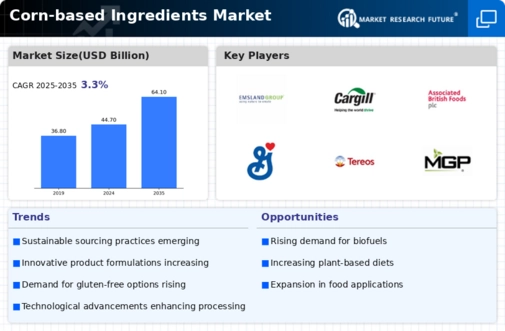Market Growth Projections
The Global Corn-based Ingredients Market Industry is poised for substantial growth, with projections indicating a market value of 44.7 USD Billion in 2024 and an anticipated increase to 64.1 USD Billion by 2035. This growth trajectory suggests a compound annual growth rate (CAGR) of 3.32% from 2025 to 2035. Such projections reflect the increasing integration of corn-based ingredients in various sectors, driven by consumer demand for convenience, health, and sustainability. The market's expansion is likely to be supported by ongoing innovations and the development of new applications, further solidifying the role of corn-based ingredients in the global economy.
Health and Nutrition Trends
In recent years, there has been a growing awareness regarding health and nutrition, influencing the Global Corn-based Ingredients Market Industry. Consumers are increasingly seeking products that align with their health goals, leading to a rise in demand for corn-based ingredients that are perceived as healthier alternatives. For instance, corn flour and cornmeal are often favored for their gluten-free properties, appealing to those with dietary restrictions. This shift is likely to contribute to the market's expansion, with projections indicating a market value of 64.1 USD Billion by 2035, suggesting a sustained interest in healthier food options.
Rising Demand for Processed Foods
The Global Corn-based Ingredients Market Industry is experiencing a notable increase in demand for processed foods, driven by changing consumer lifestyles and preferences. As more individuals seek convenient meal options, the incorporation of corn-based ingredients in snacks, sauces, and ready-to-eat meals becomes increasingly prevalent. This trend is reflected in the projected market value of 44.7 USD Billion in 2024, indicating a robust growth trajectory. The versatility of corn-based ingredients, such as corn syrup and starch, allows manufacturers to enhance flavor, texture, and shelf life, thereby catering to the evolving needs of consumers globally.
Diverse Applications Across Industries
The versatility of corn-based ingredients is a driving force in the Global Corn-based Ingredients Market Industry, as they find applications across various sectors, including food and beverage, pharmaceuticals, and cosmetics. In the food industry, corn starch is widely used as a thickening agent, while corn syrup serves as a sweetener in numerous products. This broad applicability not only supports market growth but also encourages innovation in product development. As the market continues to expand, the diverse uses of corn-based ingredients are likely to play a crucial role in achieving the projected market value of 44.7 USD Billion in 2024.
Technological Advancements in Processing
Technological innovations in processing techniques are reshaping the Global Corn-based Ingredients Market Industry, enabling more efficient and cost-effective production of corn-based products. Advances in enzymatic processing and fermentation technologies allow for the extraction of high-quality ingredients with enhanced functional properties. This not only improves product quality but also reduces waste, aligning with the industry's sustainability goals. As these technologies continue to evolve, they are expected to bolster the market's growth, contributing to the projected increase in market value to 64.1 USD Billion by 2035, thereby enhancing the overall competitiveness of corn-based ingredients.
Sustainability and Environmental Concerns
Sustainability is becoming a pivotal factor in the Global Corn-based Ingredients Market Industry, as consumers and manufacturers alike prioritize environmentally friendly practices. The cultivation of corn, when managed sustainably, can yield significant benefits, including reduced carbon footprints and improved soil health. As companies adopt sustainable sourcing and production methods, they enhance their brand image and appeal to eco-conscious consumers. This trend may drive further growth in the market, as evidenced by the anticipated CAGR of 3.32% from 2025 to 2035, reflecting a long-term commitment to sustainability in food production.





















Leave a Comment